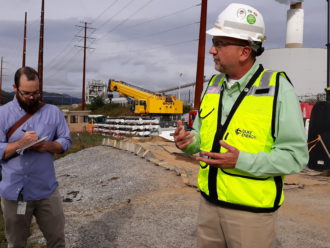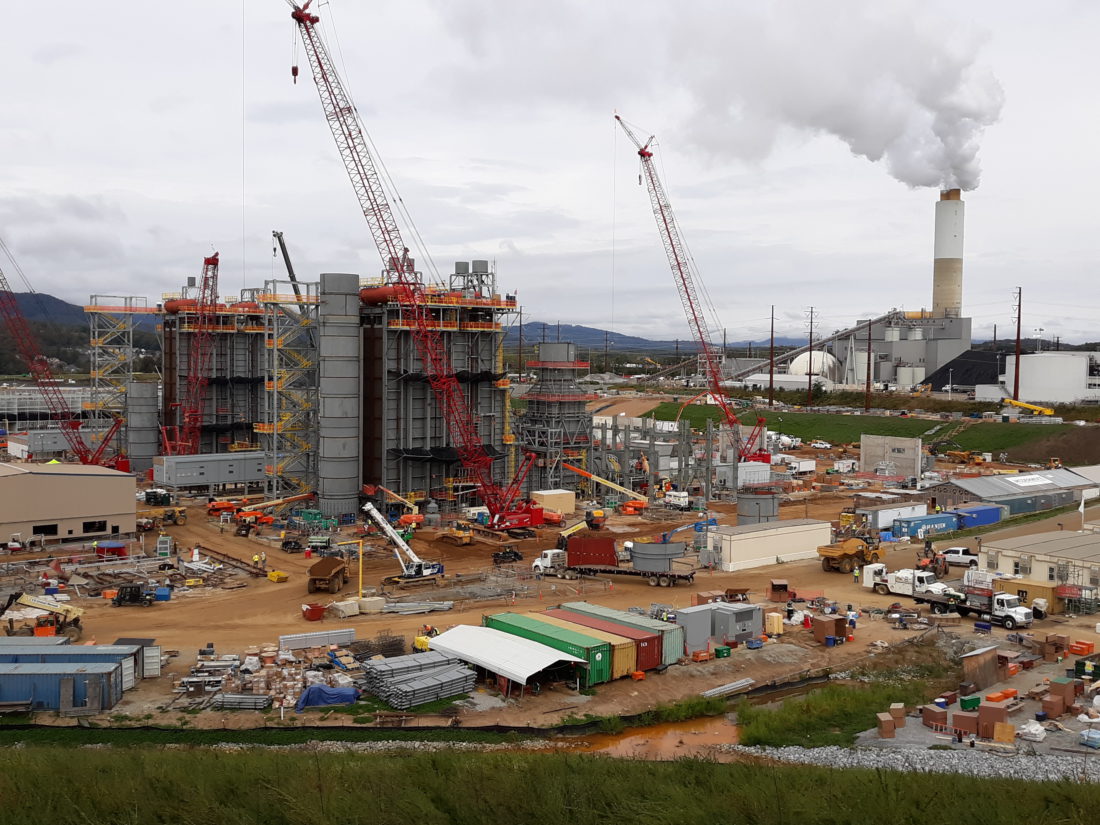The landscape of energy generation in Western North Carolina is set to change — literally. Duke Energy officials estimate that by 2024, the 376-foot scrubber stack marking the company’s coal-fired power plant in Skyland will vanish from the skyline, replaced by two much shorter cooling towers for a new facility powered by natural gas.
“I used to drive out to WNC before I was in this job, and that was always kind of the marker: I knew I was in Asheville when I could see the scrubber stack,” said Jason Walls, Duke Energy district manager. “And that will be going away over time.”
But during a media tour of the half-finished facility on Oct. 16, Walls emphasized that Duke’s transformation in the region is far more than cosmetic. The $893 million project at the Lake Julian campus comprises less than half of $2 billion in planned Asheville-area investments through 2028, including $422 million to remove millions of tons of coal ash from the site and $546 million in grid improvements.
When completed in late 2019, the gas plant will have a capacity of 560 megawatts, an increase of roughly a third over the existing facility. Producing that electricity will create 60 percent fewer carbon dioxide emissions per megawatt-hour compared to burning coal, slash sulfur dioxide emissions by an estimated 99 percent and eliminate mercury from operations.
The plant also comes with a life span of 40 years. That time frame would retire the facility in 2059, 17 years after Buncombe County government’s 2042 goal of transitioning all homes and businesses to completely renewable energy. And on Oct. 23, Asheville City Council unanimously passed a resolution to shift all government operations from fossil fuels to renewables by 2030.
Walls said that Duke is committed to partnering with local governments to achieve their goals but adds that the new plant’s construction is based on forecasts of growing energy needs. “We’re seeing significant increases in the amount of electricity that’s being demanded by our customers in WNC,” he said. “You’re going to continue to see growth in renewables, but this power plant will always be that foundation which supports the electricity needs of this region.”
Steady cycle
Gas-fired electricity, Walls said of Duke’s approach, is the most consistent way to keep the lights on for the nearly 300,000 customers the new plant will serve. This is especially true given the design of the facility, which features multiple layers of redundant production to ensure that some power is always flowing.
Although the plant will be covered by a single roof, it will employ two separate combined-cycle units, each capable of producing around 280 megawatts of power. Both of those units function in two parts — a gas-burning combustion turbine and a heat recovery steam generator that uses the turbine’s exhaust — the first of which can be operated independently in case of a problem with the second.
“You are bringing in air, you’re moving a big jet engine, you’re spinning a turbine,” Walls explained about the process. “You’re then recovering that heat to reuse to turn [another] turbine. So you’re actually generating electricity twice.”

Jeff Blackwood, construction project director for the Asheville site, said each combined-cycle unit contains a bypass stack that can be used to skip the heat recovery process altogether. “If there were a problem with the steam turbine, that bypass stack has a big damper right in the bottom of it, and we can divert the [exhaust] flow from the combustion turbines right out that bypass stack and keep them online,” he explained. “We can continue to generate some electricity while the problem with the steam gets worked out.”
While that additional reliability came at a higher upfront cost, added Blackwood, the plant’s design allowed Duke to avoid building a controversial transmission line initially proposed as part of the project plan. The 45-mile line, which would have cut through the mountains to near Gaffney, S.C., was vigorously opposed by area residents on environmental and quality-of-life grounds.
Regarding economic impacts, Walls estimated that Duke will pay about $14 million in property taxes on the site in the five years following completion, an increase of roughly 40 percent over current rates. The new plant’s efficiency means that approximately 60 workers will lose their jobs at the current coal facility, but Duke spokesperson Heather Danenhower said the company has a history of relocating talent in similar situations. And, although Duke will eventually recover its investment from ratepayers, the company says customers will see lower fuel costs on their bills.
Little bit of sunshine
The Asheville site will also feature a “massive solar farm” on the original plant’s 45-acre coal ash basin, according to Walls. The final size and capacity of the farm will depend on how much of the basin can be reclaimed; Walls said it was too early in the process to share specific numbers.
Danenhower gave the ballpark figure of 7 solar acres for 1 megawatt of generating capacity. Based on this conversion, covering the entire 45-acre basin in solar panels would create a roughly 6.4-megawatt farm, a production potential just over 1 percent of that of the adjacent gas plant.
That relative allocation to solar is in line with Duke’s overall power-generating portfolio. Renewables make up about 1 percent of its capacity, with the remainder consisting of 35 percent coal, 35 percent nuclear and 29 percent natural gas.
When asked about the project’s relative levels of gas and solar in light of local government’s ambitious renewables goals, Walls responded, “You can look at relative levels of investment on a number of fronts.” High property costs, low land availability and suboptimal sun exposure due to mountain shade make utility-scale solar a particular challenge in the region, he said.
“We’re at that point of balance between the need for land and the growth of renewables,” Walls explained. “Our commitment is a significant one for WNC, which is what we’re really proud of. It’s something that we recognize as part of a longer-term story of the transformation of our energy. It’s the start of what will come for decades.”
Change is gonna come?
But transformation over decades, suggest some local environmental groups, isn’t good enough. When Duke first announced its plans for the plant in 2015, a coalition of the Sierra Club, Southern Environmental Law Center, Waterkeeper Alliance and MountainTrue released a joint statement calling the facility “inconsistent with the clean energy future we have called for.”
SELC attorney Amelia Burnette reaffirmed that stance in comments to Xpress as the new facility nears completion. While closing the coal plant represents a positive step for air and water quality, she noted, the power company’s large infrastructure investment in natural gas remains problematic.
“Building a big gas plant here signals Duke Energy plans to lock us in to fossil fuels for some time, when we could, and should, be turning more to renewables,” Burnette said. “In contrast, Duke Energy’s plans to install solar on the site of Asheville’s former coal ash lagoons is a small step towards embracing renewables. Local governments are well-positioned to continue to encourage these types of solutions.”
Jeremiah LeRoy, Buncombe County’s sustainability officer, wrote in an Oct. 19 email to Xpress that it was important to remember the facility’s role in serving the large portion of WNC beyond the county. And as renewable infrastructure is constructed, he added, “our citizens and businesses still need reliable power to function in their daily lives.”
However, LeRoy explained, Buncombe County government remains committed to building that infrastructure and meeting its energy needs with renewables. “The county is already addressing its internal goals through increased efficiency of our own building/fleet portfolio, as well as the construction of a utility-scale solar farm on the closed landfill in Woodfin,” he wrote.
Meeting the community-level renewable goal, LeRoy added, will require “collective action.” He has been encouraged on that front by Duke’s participation in the joint county-city Energy Innovation Task Force, which researches and recommends approaches to energy efficiency, as well as its commitment to renewable projects such as a 2-megawatt solar array in Hot Springs.
Walls affirmed that Duke is committed to “really aggressive carbon reduction,” with a goal of cutting emissions across its facilities by approximately 40 percent from 2005 levels by 2030. But at least for now, he said, completely eliminating fossil fuel use is off the table.
“We believe that a diversified portfolio of generation is critical, because you have some customers who depend on electricity in the middle of the night or in the early morning and don’t have the luxury of relying solely on solar generation,” Walls said. “I don’t think you’ll ever see a Duke Energy fleet that’s 100 percent renewable because that doesn’t match up and meet all of our 9.1 million customers’ needs.”




“Walls estimated that Duke will pay about $14 million in property taxes on the site in the five years following completion, an increase of roughly 40 percent over current rates.”
Hint to MTX: I’m a capitalist and a Trump supporter and I’m not opposed to the gas conversion because fracking should produce affordable gas for as long as I live… BUT Duke is a regulated utility and so “DUKE’s CUSTOMERS will pay the increase of roughtly 40%.”
Hi,
I’m interested in the thermal efficiency of the proposed natural gas combined cycle plant. Thermal efficiency is usually expressed as a “heat rate” in British thermal units per kilowatt hour (Btu/kWh). Would it be possible to check with any of your contacts at Duke Energy to find out what the approximate heat rate is expected to be? (I’m expecting a number like 6700 Btu/kWh…)
Thanks,
Mark Bahner
Hi,
Never mind! I was able to get an email response from Duke Energy about the heat rate at the plant. (It’s much lower than 6700 Btu/kWh!)
So again, no need to contact anyone at Duke Energy. Sorry for any inconvenience I’ve caused.
Sincerely
Mark Bahner
Hi Mark, thanks much for your curiosity! For those of us with less technical savvy, can you explain what you found from Duke and what it means in terms of energy efficiency?